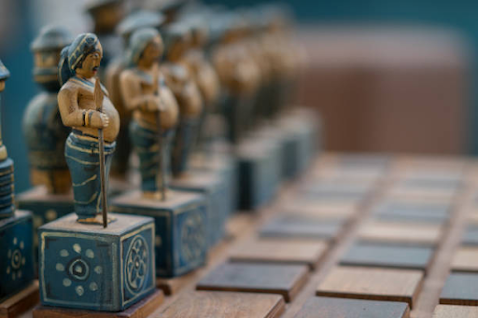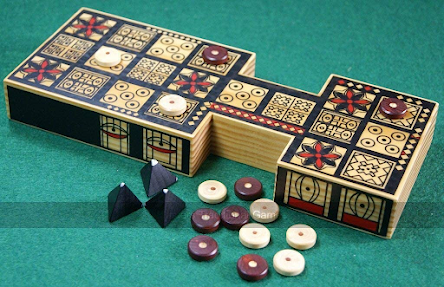Board games have been a part of everyone’s childhood, but for how long have they really existed? Let us have a look at some of the most historically known board games.
1. The Royal Game of Ur
The Royal Game of Ur is the most established playable prepackaged game on the planet, starting close to a long time back in old Mesopotamia.
The game's principles were composed on a cuneiform tablet by a Babylonian stargazer in 177 BC. From this, custodian Irving Finkel had the option to translate the principles - two players contend to race their pieces from one finish of the board to the next. The focal squares were likewise utilized for fortune-telling.
2. The Lewis Chessmen
Made in Scandinavia in the late twelfth hundred years, the skilfully cut chess pieces were tracked down on the Isle of Lewis in Scotland around 1831.
It's an idea they had a place with a shipper heading out from Norway to Ireland, and different stories have arisen to make sense of why they might have been covered there.
The chessmen are unequivocally impacted by Norse culture. This is most clear in the figures of the jailers or rooks which appear as berserkers - wild legendary fighters.
3. Wari
Wari is a round of computation and technique played generally inside West Africa and furthermore famous somewhere else on the planet - you could know it as mancala.
The point of the game is to catch the seeds of your adversary, moving them from their six playing openings to your bank.
This game board was made in Sierra Leone and is striking for its intricate sculptural base. It's enriched with a creature, perhaps a pig.
On the off chance that you don't have a game board at home, you can play by drawing two columns of six circles on a piece of paper, with an oval at each end, and utilize 48 marbles, dots, stones, or even desserts as your counters.
4. Senet
Darling by Tutankhamun and Sovereign Nefertari is the same, senet is one of the earliest realized prepackaged games, dating to around 3100 BC.
The game board contains 30 squares, spread out in three lines of 10. Two players contend to race every one of their parts of the finish of the board, utilizing projecting sticks or bones, as opposed to dice, to decide the number of squares moved with each toss.
A few sheets, similar to this one produced using an emptied-out piece of wood confronted with ivory, have totally clear squares, though others incorporate squares beautified with symbolic representations addressing extra game guidelines.
On this papyrus, dating to around 1250-1150 BC, a lion plays senet with a gazelle, in spite of experiencing a touch of difficulty holding the pieces.
5. Mahjong
First played during the Qing tradition in China (1644-1912), mahjong is a methodology-based game played utilizing tiles. They are customarily enhanced with Chinese characters, bamboo branches and dabs, and extraordinary tiles are demonstrated with winds, mythical beasts, blossoms and seasons. This deficient set has 140 of the first 144 tiles, which are produced using bamboo and bone - each tile weighs only six grams.
It is compared by and by to the game rummy, and four players attract and dispose of tiles to finish their hand. The point of the game is to get each of the 14 of your tiles into four sets and one set.
Mahjong was acquainted with the West in the nineteenth hundred years and has filled in notoriety universally since.
6. The Game of the Goose
The earliest financially delivered prepackaged game, the Game of the Goose is a shot in the dark and karma, including no methodology by any stretch of the imagination.
Duke Francesco de Medici previously gifted the game, then called Gioco dell'Oca to Philip II of Spain somewhere in the range of 1574 and 1587, and the leisure activity immediately spread in prevalence all through Europe. These models dating from 1774 to the late nineteenth century remember the guidelines for French, German and Italian.
The point of the game is to get your counter to the focal point of the load up, moving counterclockwise as per rolls of a bite the dust. A few spaces are joined by unique guidelines - for instance, in the event that you land on number 58 you should begin the game once more, or on the other hand assuming that you land on number 19 you could pay a relinquish and drink until your next turn. Players should score an ideal 63 to dominate the match.
7. Ajax and Achilles' Down of Dice
Made in Athens around 530 BC, this amphora shows Ajax and Achilles - two of the legends of the Trojan conflict - playing a tabletop game, potentially with pessi, or dice.
Seven counters or dice are apparent on the game board, and Ajax contacts get one of his pieces for the following toss, as they pass the hours between the battling.
We can't rest assured what game they were playing, or the way that the dice were scored, yet a comparable may be backgammon, which includes the two counters and dice. It goes back almost 5,000 years to Mesopotamia, and adaptations were played in the Byzantine Domain in the fifth hundred years and in sixth century Persia.
Written By: Sofia Choudhary
Edited By: Nidhi Jha

















0 Comments